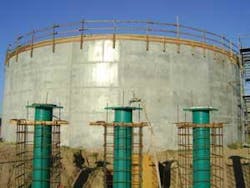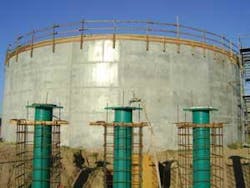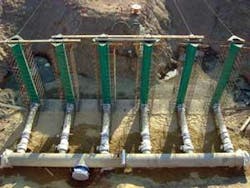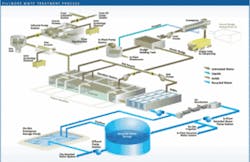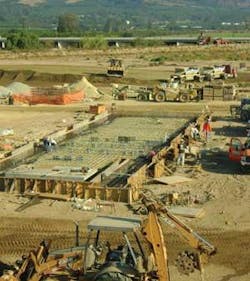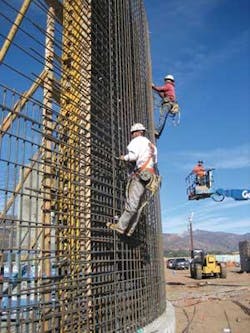DBO Project Delivers Savings On MBR Facility
By Greg Chung
The Fillmore Wastewater Treatment Plant (WWTP) was already half a century old when the Los Angeles Regional Water Quality Control Board issued a new National Pollutant Discharge Elimination System (NPDES) permit for the aging plant. The City of Fillmore studied several options and decided that the soundest solution to bring the 50-year-old plant into compliance was to end discharge to the Santa Clara River and to build a new plant at a different location.
The city is building a $42.5 million, zero-discharge plant that meets the stringent requirements of California’s Title 22 regulations for the production of recycled water. The project will replace the city’s outdated WWTP with an efficient 1.8 MGD membrane bioreactor (MBR) plant that will eventually produce reclaimed water that is used for irrigation within the city. To reduce costs, the city is using a Design/Build/Operate (DBO) approach that has resulted in substantial savings.
The project began when the city decided to abandon the old facility, built in 1955, and construct a new plant on city-owned farmland. From three teams submitting proposals, the city selected American Water Company to lead the DBO team of W.M. Lyles Construction Company and Kennedy/Jenks Consultants (design engineer). When construction is complete, American Water will maintain and operate the wastewater treatment system over the next 20 years.
“With a DBO team you have a design engineer and a contractor familiar with building treatment plants, and an operator familiar with operating it,” said Bert Rapp, city Public Works Director. “That gives us the best combination with three parties at the design table, the construction site, and finally in the operation of the plant. The DBO team we selected gives us the most economical method and the highest value in building the treatment plant.”
Substantial cost savings have come from using a design-build open-book model. The project team used an itemized list of cost items that was open to all members of the DBO team. All four parties (city, American Water, W.M. Lyles, and Kennedy/Jenks Consultants) were looking for more efficient ways to complete the project without sacrificing the overall quality. DBO project delivery along with the open-book model helped all parties understand the cost implications (positive and negative) of design decisions as the process moved forward.
Design Elements
A unique plant feature is the ability to “peak-shave” electrical use during the hours when power usage is highest. The price for power is highest between noon and 6 p.m. Since the typical peak flow of wastewater comes in at 9 a.m., the plant normally treats the most flow when electrical prices are highest. Processes like aeration and UV disinfection use substantial amounts of power. The flow-equalization system at the beginning of the treatment process was designed to “shave” (remove) the extreme peaks by day and the deep lows at night. Peak shaving allows the city to minimize flow during the day and to meter the wastewater back into the plant for treatment when power demand (and cost) is lower.
The daily flow rate to the plant is estimated to vary between 0.40 mgd to 6 mgd and this flow range would be equalized to roughly 2 mgd throughout the day. During a storm event, the flow-equalization system is designed to equalize the peak flow from 9.0 mgd to 6.0 mgd.
The new plant will use a biological nutrient removal (BNR) membrane process to remove nitrogen from the incoming wastewater.
“Previous estimates showed that a membrane plant costs about 5-10% more than a conventional activated sludge plant, with the cost of membrane plants coming closer each year. But when the DBO bids were received, all three bidders submitted MBR proposals because membranes were more cost effective and provide water that is 10 times cleaner,” Rapp said. “To meet future wastewater treatment permits, we decided that our best investment would be a BNR membrane process. The new plant, scheduled for completion in August 2009, takes advantage of the most recent improvements in MBR technology.”
In the MBR tanks, membrane elements are submerged in the biological mixed liquor. The membranes have a pore size of 0.04 µm. Effluent turbidity from the MBR system is designed so that it does not exceed 0.2 Nephelometric Turbidity Units (NTU) more than 5 percent of the time within any calendar day and 0.5 NTU at any time.
Product water production through each MBR tank is regulated by permeate pumps that pull water through the membranes from the MBR tanks. Flow is regulated through each permeate pump based on pressure and flow measurements from each MBR basin. Permeate flow from each MBR tank is controlled to maintain the flux rates indicated in the following table.
The flow capacity of the membrane system is 6.0 mgd with one of the four MBR tanks out of service. Each MBR tank has a dedicated permeate pump and return sludge pump. The return sludge pump is used to regulate the mixed liquor concentration in the MBR tank.
Another innovative element is that the plant recycles 100% of treated water to avoid discharges to the Santa Clara River.
“The options were discharge to the river, 50-50 discharge and recycle, or 100% recycle,” Rapp said. “We found that the cost of 100% recycling was the same as that for discharging to the river. When we factored in the unknown future regulations for the river discharge alternative, we concluded that the best investment was recycling, where the regulatory requirements are more stable. None of the water will be discharged to a surface water body. It will be used to irrigate schools, landscape, city parks, business parks, and green areas. Using recycled water for irrigation also reduces demand for potable water supplies.”
A key component for producing recycled water is the ultraviolet (UV) disinfection system. The UV Disinfection system consists of one UV channel with four separate banks of UV lamps. The system is designed to deliver a UV dose of 80,000 µWatt.secs/cm2 at a peak flow of 6.0 MGD with one of the four UV banks out of service. To account for inefficiencies in the UV lamp arrays, 30 percent additional lamps are provided in the lamp array. Lamp sleeves will be cleaned by an automatic mechanical wiper system that does not require that lamps or modules be out of service during cleaning.
The new WWTP facilities also include a recycled water storage tank, effluent pumping station, and effluent pipeline. The effluent pipeline is the first section of a city-wide distribution system that will convey water to parks, schools, and landscape areas. The recycled water storage tank has a storage capacity of 1 million gallons and the effluent pumping station has a peak pumping capacity of 2,895 gallons per minute. To assist in design and management of power and pumping resources, the city will control the irrigation sites that are scattered throughout the city via a fiber optic network.
null
Conclusion
By using the DBO approach, the city can construct the new plant for 15% less than the cost of similar WWTPs in neighboring communities.
“I believe that much of the savings are due to the DBO process, which allows us to execute the project faster,” Rapp said. Prolonging the process would have increased the cost of the project due to inflation.
The DBO process gives the city a single contract and a guaranteed cost and allows them to budget and manage costs effectively.
“We have trimmed about $10 million on the overall project with the help of the DBO contract,” Rapp said. “In the open-book contract with the American Water team, we share the savings 50-50. If either side comes up with a creative way to lower costs, we put it on the table, and if we all agree, we implement the idea and share the savings. We have a $42.5 million DBO contract, and the open book currently has about $2 million of savings in it.” WW
About the Author:
Greg Chung is a Project Manager for Kennedy/Jenks Consultants, Palo Alto, CA. He may be contacted at [email protected].
